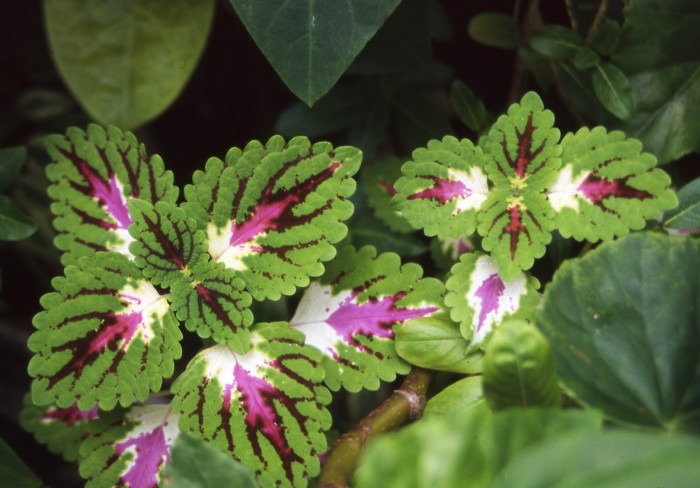For sheer colour in the greenhouse there is little to compare with Coleus or Painted Nettles as they are so accurately described. Indeed these not only closely resemble Dead Nettles but are in fact closely related to them.

Now many have been renamed Plectranthus or Solenostemon though these have not caught on. The commonest, Coleus blumei, now Solenosteon scutellarioides, hails from Malaysia and SE Asia and was long loved by florists for providing foliage colour though then perhaps because of too frequent sales at school fetes it fell out of popularity. Or rather I should say they because seldom were two Coleus ever the same. With brilliant leaf colours from near black through greens of all hues, purples, reds, scarlets, pink and yellows these give lots of decorative impact for very little effort.
Seeds of several strains are available from most catalogues and can be easily germinated in the warm and grown on in any reasonable potting compost (though they like extra leaf-mould mixing in if you have any). Each and every seedling will be differently coloured and patterned, some can also have exaggeratedly serrated edges to their leaves. The, usually blueish, flower spikes themselves resemble those of Clary Sage and though these are attractive to bees they’re not a great feature so are best removed early on so as to encourage better bigger foliage.
Coleus can be used in summer bedding schemes outside and will even put on a good display in partly shady conditions so are good fillers. But they’re seen at their best grown as individual plants in quarter litre pots with their shoot tips nipped out methodically to produce squat bushes up to a foot or so and across. By nipping out the tips the leaves get bigger and more impressive. But even better- these tips or whole shoots can be very easily rooted (in sharp sand or grit over warmth) and so a particularly choice specimen can be multiplied wholesale, and conveniently these can also be used for annual replacement. This is rather necessary as older plants get unkempt and worse are rather attractive to mealy bug. Indeed it is worth having a few Coleus to serve as indicator plants just to tell you whether mealy bugs have found their way into your greenhouse.
Rooting new plants in late summer from carefully inspected shoots and over-wintering these allows the old plants to be discarded taking any infestations with them. It is almost certainly the ease with which Coleus can be multiplied that made it so popular for school plant stalls and thus it’s fall from general use, which is a shame. The breeders have been at work though and newer even brighter, and darker, variations are available, some producing leaves up to a foot long and now some which remain bushy without their tips being nipped out. There are other species available for the plant connoisseur including the trailing C. pumilus and C. aromaticus used medicinally in India and Sri-Lanka.


